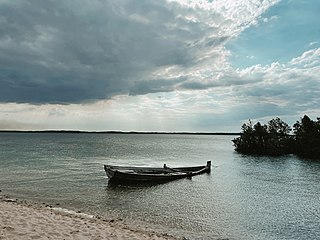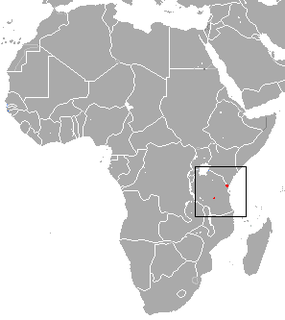Gallery
- Mangapwani
- A cave in Zanzibar
This is a list of caves in Tanzania.

Tanga is both the name of the most northerly port city of Tanzania on the west of the Indian Ocean, and the capital of Tanga Region. It had a population of 273,332 in 2012. The name Tanga means "sail" in Swahili.

Lindi Region is one of Tanzania's 31 administrative regions. The regional capital is the municipality of Lindi. The region is home to two UNESCO World Heritage Sites, namely; Kilwa Kisiwani and Selous Game Reserve. According to the 2012 national census, the region had a population of 864,652, which was lower than the pre-census projection of 960,236. For 2002–2012, the region's 0.9 percent average annual population growth rate was the 29th highest in the country. It was also the least densely populated region with 13 people per square kilometer.

Tanga Region is one of Tanzania's 31 administrative regions. The regional capital is the municipality of Tanga city. Located in northeast Tanzania, the region is bordered by Kenya and Kilimanjaro Region to the north; Manyara Region to the west; and Morogoro and Pwani regions to the south. It has a coastline to the east with the Indian Ocean. According to the 2012 national census, the region had a population of 2,045,205.
The lesser long-fingered bat, also known as the black clinging bat or lesser bent-winged bat, is a species of vesper bat in the family Vespertilionidae.

Hildegarde's tomb bat is a species of sac-winged bat in the family Emballonuridae. It is found near the coast in Kenya and Tanzania where it feeds in tropical dry forests and roosts in caves. It is a diurnal species and the International Union for Conservation of Nature has assessed its conservation status as being endangered. The specific name hildegardeae was given in honour of anthropologist Hildegarde Beatrice Hinde.

The reddish-gray musk shrew is a species of mammal in the family Soricidae. It is found in Angola, Botswana, Democratic Republic of the Congo, Eswatini, Lesotho, Malawi, Mozambique, Namibia, Nigeria, South Africa, Tanzania, Zambia, and Zimbabwe. Its natural habitats are temperate forests, subtropical or tropical moist lowland forest, subtropical or tropical high-altitude grassland, and caves.

Darling's horseshoe bat is a species of bat in the family Rhinolophidae found in Africa. Its natural habitats are dry savanna, caves, and subterranean habitats.

Decken's horseshoe bat is a species of horseshoe bat. It is found in Kenya and Tanzania. Its natural habitats are subtropical or tropical moist lowland forest, subtropical or tropical moist montane forest, moist savanna, caves, and subterranean habitats. It is threatened by habitat loss.

The Maendeleo horseshoe bat is a recently discovered species of bats in the family Rhinolophidae. It inhabits caves of the Coastal Lowland forests of Tanzania. Its closest relative is the Adam's horseshoe bat. It was described in 2000.

The Bushveld horseshoe bat is a species of bat in the family Rhinolophidae.

David John Shaw was an Australian scuba diver, technical diver, and airline pilot for Cathay Pacific, flying the Lockheed L-1011 Tristar, then the 747-400, and then the A330-300, A340-300, and A340-600. He flew for Cathay Pacific from 1989 until his death in 2005. Before flying for Cathay Pacific he flew for Missionary Aviation Fellowship in Papua New Guinea and Tanzania. He also flew agricultural aircraft in South Australia and New South Wales.
Mumba Cave, located near the highly alkaline Lake Eyasi in Karatu District, Arusha Region, Tanzania. The cave is a rich archaeological site noted for deposits spanning the transition between the Middle Stone Age and Late Stone Age in Eastern Africa. The transitional nature of the site has been attributed to the large presence of its large assemblage of ostrich eggshell beads and more importantly, the abundance of microlith technology. Because these type artifacts were found within the site it has led archaeologists to believe that the site could provide insight into the origins of modern human behavior. The cave was originally tested by Ludwig Kohl-Larsen and his wife Margit in their 1934 to 1936 expedition. They found abundant artifacts, rock art, and burials. However, only brief descriptions of these findings were ever published. That being said, work of the Kohl-Larsens has been seen as very accomplished due to their attention to detail, especially when one considers that neither was versed in proper archaeological techniques at the time of excavation. The site has since been reexamined in an effort to reanalyze and complement the work that has already been done, but the ramifications of improper excavations of the past are still being felt today, specifically in the unreliable collection of C-14 data and confusing stratigraphy.
The Battle of Kibata was fought north-west from Kilwa during the East African Campaign of World War I. The British theatre commander, South African General Jan Smuts, planned to seize Kibata and prevent German forces from withdrawing southwards.

Friedrich Wilhelm Conrad Eduard Bornhardt was a German geologist, engineer and explorer, and was Director of the Berlin College of Mines (Bergakademie) from 1907 to 1916.

Njombe Region is one of the 31 administrative regions of Tanzania. It was established in March 2012, from the Iringa Region as an independent region. The region's capital is Njombe town. The newly established Njombe region is an upcoming tourism attractive area, ideal for domestic and international visits in the southern highlands of Tanzania.
The Mangapwani Lighthouse is located in Bumbwini, Zanzibar, Tanzania. The lighthouse is one of the oldest lighthouses on the island and is a square stone tower, painted with black and white horizontal bands. The lighthouse is near the Mangapwani slave caves, which were built after the slave trade was abolished in 1873. According to a July 2008 article in Lighthouse Digest, the lighthouse is area is abandoned and stripped by vandals.
Kibata is an administrative ward in Kilwa District of Lindi Region in Tanzania. The ward covers an area of 139.5 km2 (53.9 sq mi), and has an average elevation of 415 m (1,362 ft). According to the 2012 census, the ward has a total population of 8,730. The ward seat is Kibata village.
Nan'goma Cave is a cave system located in Kipatimu and Kibata ward of Kilwa District in Lindi Region of Tanzania.
The Matumbi Highlands or Matumbi Hills is a major highland of southern Tanzania, extending from southern Pwani Region to northern Kilwa District of Lindi Region. The Matumbi highlands are named after the peoples that were the original inhabitants of the area, the Matumbi people. The average elevation of the highlands is 442m. The highlands are located in Kibata, Kipatimu, Chumo, Kinjumbi and Mingumbi wards of Kilwa District. In Pwani Region the highlands are found in Mbwara and Chumbi wards. The highlands are athe location of Nan'goma Cave system.
| Wikimedia Commons has media related to Caves in Tanzania . |